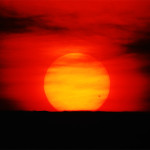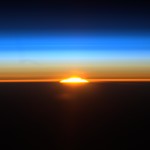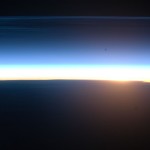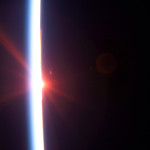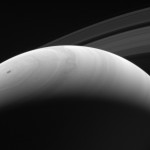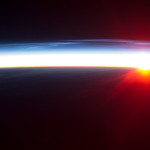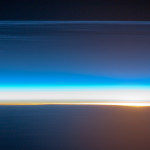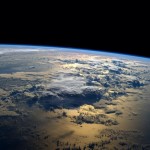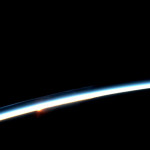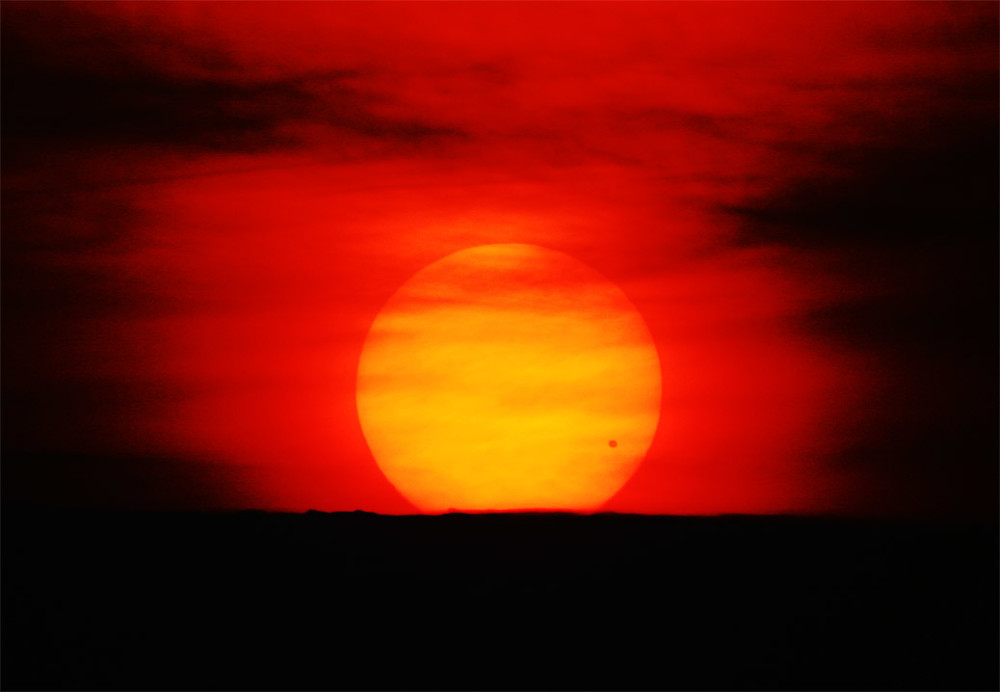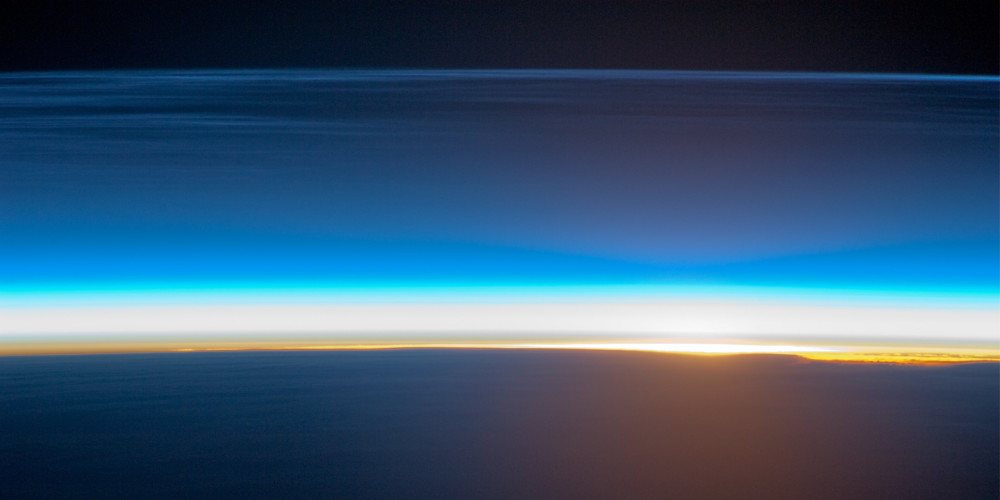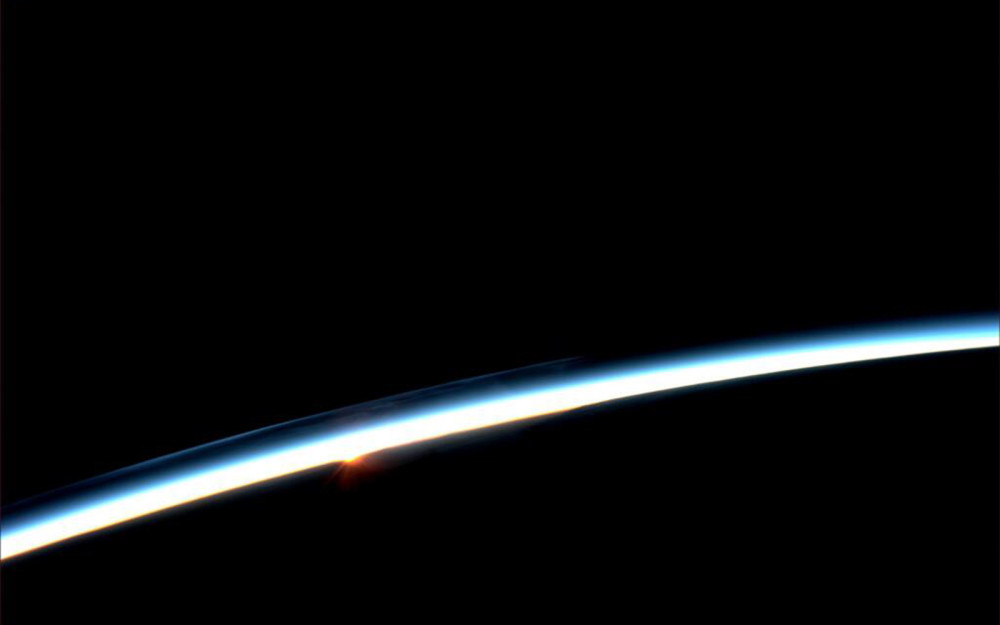- Sunrise with Transit of Venus 2004
- Rising sun from ISS
- Orbital Sunrise
- Sunrise in Space
- Sunrise on Saturn
- Sunrise over the Aleutian Islands, with Noctilucent Clouds
- Polar Mesospheric Clouds Illuminated by Orbital Sunrise
- An Astronaut’s View from Space
- First Hint of Sunrise From Space
Sunrise with Transit of Venus 2004
Sunrise with Transit of Venus 2004
Venus Transit at sunrise on June 8, 2004. The planet Venus, filtered by haze, is on the right. Photo taken from West Orange, New Jersey, USA.
Image Credit: NASA/John Cudworth.
Sunrise in Space
Sunrise in Space
This view featuring a sunrise dissecting a line of airglow of Earth’s atmosphere was photographed by an STS-114 crewmember onboard Space Shuttle Discovery after departure from the International Space Station.
Image Credit: NASA
Polar Mesospheric Clouds Illuminated by Orbital Sunrise
Polar Mesospheric Clouds Illuminated by Orbital Sunrise
Polar mesospheric clouds can be observed from both the Earth’s surface and in orbit by astronauts aboard the International Space Station (ISS). The clouds are also called noctilucent, or “night-shining,” clouds because they are usually seen at twilight. When the Sun sets below the horizon and the Earth’s surface gets dark, these clouds are still briefly illuminated by sunlight. Occasionally the space station’s high-altitude orbital track becomes nearly parallel to the Earth’s day/night terminator for a time, allowing polar mesospheric clouds to be visible to the crew at times other than the usual twilight.
This unusual astronaut photograph shows polar mesospheric clouds illuminated by the rising, rather than setting Sun. Low clouds on the horizon appear yellow and orange, while higher clouds and aerosols (particles like dust and pollution) are illuminated a brilliant white. Polar mesospheric clouds appear as light blue ribbons extending across the top of the image. These clouds typically occur at high latitudes of both the Northern and Southern Hemispheres, and high altitudes (76–85 kilometers, near the boundary between the mesosphere and thermosphere atmospheric layers).
The ISS was located over the Greek island of Kos in the Aegean Sea (near the southwestern coastline of Turkey) when the image was taken at approximately midnight local time. The ISS was tracking northeastward, nearly parallel to the terminator, making it possible to observe an apparent “sunrise” almost due north. Earlier this year, a similarly unusual alignment of the ISS orbit track, the terminator position, and the seasonal position of the Earth in its orbit around the Sun allowed astronauts to capture striking imagery of polar mesospheric clouds over the Southern Hemisphere.
Image Credit: NASA
Rising sun from ISS
Rising sun from ISS
On Saturday, June 11, 2011, International Space Station astronaut Ron Garan used a high definition camera to film one of the sixteen sunrises astronauts see each day. This image shows the rising sun as the station flew along a path between Rio de Janeiro, Brazil and Buenos Aires, Argentina.
Image Credit: NASA
Sunrise on Saturn
Sunrise on Saturn
A new day dawns on Saturn as the part of the planet seen here emerges once more into the Sun’s light.
With an estimated rotation period of 10 hours and 40 minutes, Saturn’s days and nights are much shorter than those on Earth.
This view looks toward the sunlit side of the rings from about 25 degrees above the ringplane. The image was taken with the Cassini spacecraft wide-angle camera on Aug. 23, 2014 using a spectral filter which preferentially admits wavelengths of near-infrared light centered at 939 nanometers.
The view was acquired at a distance of approximately 1.1 million miles (1.8 million kilometers) from Saturn and at a Sun-Saturn-spacecraft, or phase, angle of 127 degrees. Image scale is 67 miles (108 kilometers) per pixel.
The Cassini-Huygens mission is a cooperative project of NASA, the European Space Agency and the Italian Space Agency. The Jet Propulsion Laboratory, a division of the California Institute of Technology in Pasadena, manages the mission for NASA’s Science Mission Directorate, Washington, D.C. The Cassini orbiter and its two onboard cameras were designed, developed and assembled at JPL. The imaging operations center is based at the Space Science Institute in Boulder, Colo.
Image Credit: NASA/JPL-Caltech/Space Science Institute
An Astronaut’s View from Space
An Astronaut’s View from Space
NASA astronaut Reid Wiseman tweeted this photo from the International Space Station on Tuesday morning, Sept. 2, 2014. “My favorite views from #space – just past #sunrise over the ocean,” the Expedition 40 astronaut tweeted.
The Expedition 40 crew has been busy aboard the space station, recently performing health checks and humanoid robot upgrades. In the meantime, a trio of orbital residents is packing up gear as they prepare to return home in less than two weeks. Commander Steve Swanson powered down and stowed Robonaut 2 after wrapping up its mobility upgrades this week. He installed new legs on the humanoid robot including external and internal gear as well as cables. This sets the stage for more upgrades in the fall before Robonaut takes its first steps as an assistant crew member. Robonaut was designed to enhance crew productivity and safety while also aiding people on Earth with physical disabilities.
Image Credit: NASA/Reid Wiseman
Orbital Sunrise
Orbital Sunrise
The Expedition 24 crew on the International Space Station photographed this image of polar mesospheric clouds illuminated by an orbital sunrise. Polar mesospheric, or noctilucent (“night shining”), clouds usually are seen at twilight, following the setting of the sun below the horizon and darkening of Earth’s surface. Occasionally the station’s orbital track becomes nearly parallel to Earth’s day/night terminator for a time, allowing the clouds to be visible to the crew at times other than the usual twilight because of the station’s altitude.
This photograph shows polar mesospheric clouds illuminated by the rising, rather than setting, sun at center right. Low clouds on the horizon appear yellow and orange, while higher clouds and aerosols are illuminated a brilliant white. Polar mesospheric clouds appear as light blue ribbons extending across the top of the image. The station was located over the Greek island of Kos in the Aegean Sea (near the southwestern coastline of Turkey) when the image was taken at approximately midnight local time. The orbital complex was tracking northeastward, nearly parallel to the terminator, making it possible to observe an apparent “sunrise” located almost due north. A similar unusual alignment of the ISS orbit track, terminator position and seasonal position of Earth’s orbit around the sun allowed for this striking imagery of over the Southern Hemisphere.
Image Credit: NASA
Sunrise over the Aleutian Islands, with Noctilucent Clouds
Sunrise over the Aleutian Islands, with Noctilucent Clouds
Astronauts on the International Space Station (ISS) took this panoramic photo looking northeast from a point half-way along the Aleutian Island chain. They were flying east at “the top of the orbit”—the northernmost latitude reached by the ISS (51.6 degrees north). If the Sun had been higher, western Alaska would have been visible in the foreground; instead, it lies on the dark side of the day-night line.
This image was taken about 15 minutes after local midnight in early August 2013. From their vantage point at 222 kilometers altitude, the astronauts were able to look northeast and see a near-midnight sunrise (when it was approaching noon in England). The rising Sun makes a red, teardrop-shaped reflection in the lower center of the image—perhaps a reflection within the camera lens, from the window frame, or from some item inside the spacecraft.
Long, blue-white ripples appear in the atmosphere above the midnight sun. These are noctilucent or “night-shining” clouds. Some astronauts say these wispy, iridescent clouds are the most beautiful phenomena they see from orbit. Noctilucent clouds are best seen after sunset, when the viewer is on the night side of the day-night line and these high clouds are still lit by the Sun. Crews are trained in this somewhat complicated geometry of clouds being lit from beneath, the spacecraft in sunlight, and the ground below in darkness.
Noctilucent clouds are also known as polar mesospheric clouds (PMCs), as they appear in the summer hemisphere over polar latitudes. Some data suggest that these clouds are becoming brighter and appearing at lower latitudes, perhaps as an effect of global warming. A comparison of noctilucent cloud formation from 2012 and 2013 has been compiled using data from NASA’s Aeronomy of Ice in the Mesosphere (AIM) spacecraft. You can see the sequence here.
Polar mesospheric clouds are interesting because they form much higher in the atmosphere (75 to 90 kilometers) than the normal rainclouds that form in the lowest, densest, “weather-layer” below 15 kilometers. The weather layer, or troposphere, appears in this image as a thin, orange line along the left horizon.
Image Credit: NASA
First Hint of Sunrise From Space
First Hint of Sunrise From Space
On July 30, 2013, Expedition 36 Flight Engineer Karen L. Nyberg of NASA took this photograph of a sunrise viewed from the International Space Station. As the space station orbits the Earth every 90 minutes, traveling at about 17,500 miles per hour, the crew sees about 16 sunrises and sunsets daily.
Image Credit: NASA

